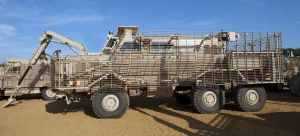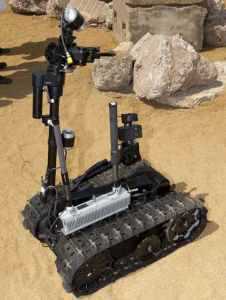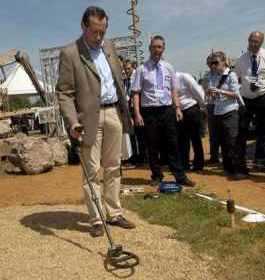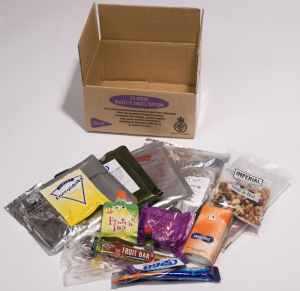Articles >>
Latest counter-IED equipment showcased
Category: Defence Industry

Tackling the threat from improvised explosive devices (IEDs) was top of the agenda at the MOD's Defence Equipment and Support showcase event, Defence Vehicle Dynamics (DVD), this year. Report by Sharon Kean. New Minister for Defence Equipment, Support and Technology, Peter Luff, formally opened this year's show at the Millbrook vehicle testing ground in Bedfordshire. Mr Luff was then given a demonstration of some of the latest counter-IED (C-IED) equipment being used by British troops and met soldiers who had survived IED blasts thanks to the heavily armoured vehicles in which they were travelling. Speaking at the event he said: "Tackling the IED threat is vital for us to make military progress. C-IED is not just about the bomb disposal expert defusing a bomb, vital and dangerous though that role is. It is about making sure that our soldiers have a range of tools, tactics and techniques available to them." Mr Luff was given a guided tour of the five pieces of equipment that make up Talisman, the newest military solution to the IED problem. The five elements consist of two enormous armoured vehicles, a JCB digger, a bomb disposal robot and a UAV (unmanned aerial vehicle). The Talisman system is currently being used by Royal Engineers to clear and build safe routes around Helmand province in Afghanistan. A Mastiff armoured vehicle and its crew act as Talisman's eyes, with video screens inside the rear compartment of the truck displaying aerial video footage gathered by a Honeywell T-Hawk UAV. |

Another armoured vehicle known as Buffalo has a remote-controlled, extendable, pronged arm attached to the front, which is used to comb or 'rummage' the ground, detecting signs of IEDs. The JCB digger is used to fill in ditches or potholes that might prevent soldiers or vehicles from moving forward and the Talon remote-controlled robot gives troops the safer option of remaining out of harm's way when trying to deal with any devices they find. Group Captain Paul Ridge, the head of the Military Manouevre Support Team that spent around 18 months developing the Talisman system, said the aim was to enable soldiers to move around the battlefield more easily: "It's a range of equipment that has been brought together to make a system which allows early detection and the choice of either avoiding or destroying the IED. "It can be used on its own or in support of other vehicles. And the whole system can be operated from under armour. It's just one part of the contribution towards counter-IED." Soldiers from 1st Battalion The Royal Welsh who survived two IED blasts in two days while in Afghanistan met the minister and described how the heavily armoured vehicles in which they were travelling probably saved their lives. Fusilier Danny Hughes, who was travelling in one vehicle when it hit a roadside bomb, said: |

"The Mastiff is worth its weight in gold. The second time it happened there weren't any injuries either, it was almost a case of 'here we go again', that's another few hours until we can have a cup of tea." The battle to beat the IEDs is the driving force behind an MOD contract for a tranche of 200 new Light Protected Patrol Vehicles. Two companies, SupaCat and Force Protection Europe, are competing for the contract and displayed prototype models of what they hope will be the next generation of Light Protected Patrol Vehicles (LPPVs). The vehicles will be used for a variety of patrols and so must be tough enough to cope with cross-country terrain, but also enable the troops inside to engage with the local people they encounter in more urban areas. General Sir Kevin O'Donoghue, Chief of Defence Materiel and the Head of Defence Equipment and Support, said: "As well as its protection against blasts, the LPPV must be able to operate in the harsh conditions of the desert and tight urban environments." Mr Luff added: "We will agree a contract for an initial tranche of 200 vehicles under an Urgent Operational Requirement funded from the Treasury Reserve later this year." |

The first batch of vehicles is required for training by the end of 2011. At the DVD event Mr Luff also announced a contract for more than 140 extra Jackal 2A weapons-mounted patrol vehicles in a deal worth about £45m, bringing the number of Jackal vehicles for Defence to over 500, and an extra 28 Wolfhound heavy tactical support vehicles under a £20m deal. Meanwhile, the MOD is reducing the weight troops on the front line carry with improvements to current and future infantry combat and support kit. Currently, the average weight of equipment carried by an infantryman is around 66kg, but innovative weight-saving schemes have shaved more than 4.5kg from this. New kit being delivered in October could reduce this by a further 8kg. Measures implemented include:
After inspecting some of the equipment at the annual DVD event and talking to soldiers and suppliers, Minister for International Security Strategy, Gerald Howarth, said: "While the modern combat soldier is better equipped than ever before, this has brought about its own challenges - mainly an increase in the weight being carried. |

"The welfare of our troops is paramount and so the work being carried out here to reduce this burden is essential to both the physical and mental well-being of our troops fighting on the front line in what can be 50-degree temperatures. The other improvements announced today are a further demonstration of our determination to equip our forces on the front line with the kit they need." A newly-formed project team, - the Integrated Soldier System Executive, based at Defence Equipment and Support in Bristol, has been leading on the work to reduce the weight carried on the front line. Along with lightening a soldier's load, the welfare of personnel operating in remote locations is being improved through increasing the number of e-bluey computer terminals to enable them to communicate with loved ones and installing more showers, sinks and toilets in forward operating bases. The new ablutions facilities will be sent to Afghanistan later this year. |
UK MoD |
QinetiQ and Pratt Miller Deliver First Robotic Combat Vehicle - Light to U.S. Army
02.02.2021
Oshkosh Defense Receives Order for 248 Joint Light Tactical Vehicles
02.07.2020
Kungas Unmanned Ground Vehicle Tested in Russia
11.12.2019
Honeywell Defence Aviation Systems
G-NIUS Unmanned Ground Systems (UGS) LTD
Discuss
